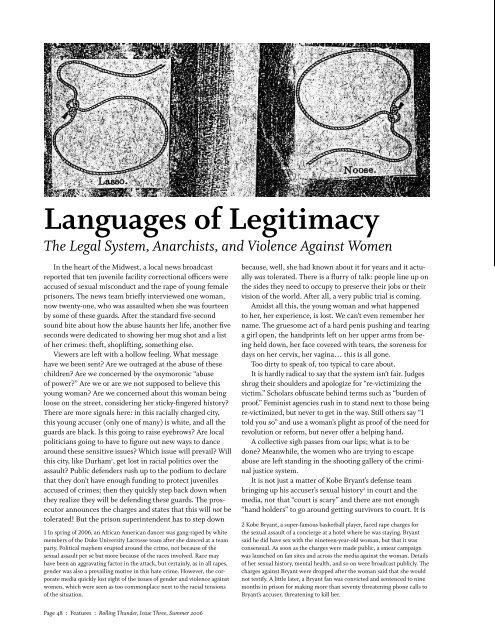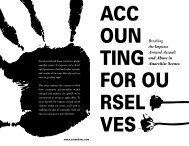Rolling Thunder - CrimethInc
Rolling Thunder - CrimethInc
Rolling Thunder - CrimethInc
You also want an ePaper? Increase the reach of your titles
YUMPU automatically turns print PDFs into web optimized ePapers that Google loves.
Languages of LegitimacyThe Legal System, Anarchists, and Violence Against WomenIn the heart of the Midwest, a local news broadcastreported that ten juvenile facility correctional o∞cers wereaccused of sexual misconduct and the rape of young femaleprisoners. The news team briefly interviewed one woman,now twenty-one, who was assaulted when she was fourteenby some of these guards. After the standard five-secondsound bite about how the abuse haunts her life, another fiveseconds were dedicated to showing her mug shot and a listof her crimes: theft, shoplifting, something else.Viewers are left with a hollow feeling. What messagehave we been sent? Are we outraged at the abuse of thesechildren? Are we concerned by the oxymoronic “abuseof power?” Are we or are we not supposed to believe thisyoung woman? Are we concerned about this woman beingloose on the street, considering her sticky-fingered history?There are more signals here: in this racially charged city,this young accuser (only one of many) is white, and all theguards are black. Is this going to raise eyebrows? Are localpoliticians going to have to figure out new ways to dancearound these sensitive issues? Which issue will prevail? Willthis city, like Durham 1 , get lost in racial politics over theassault? Public defenders rush up to the podium to declarethat they don’t have enough funding to protect juvenilesaccused of crimes; then they quickly step back down whenthey realize they will be defending these guards. The prosecutorannounces the charges and states that this will not betolerated! But the prison superintendent has to step down1 In spring of 2006, an African American dancer was gang-raped by whitemembers of the Duke University Lacrosse team after she danced at a teamparty. Political mayhem erupted around the crime, not because of thesexual assault per se but more because of the races involved. Race mayhave been an aggravating factor in the attack, but certainly, as in all rapes,gender was also a prevailing motive in this hate crime. However, the corporatemedia quickly lost sight of the issues of gender and violence againstwomen, which were seen as too commonplace next to the racial tensionsof the situation.because, well, she had known about it for years and it actuallywas tolerated. There is a flurry of talk: people line up onthe sides they need to occupy to preserve their jobs or theirvision of the world. After all, a very public trial is coming.Amidst all this, the young woman and what happenedto her, her experience, is lost. We can’t even remember hername. The gruesome act of a hard penis pushing and tearinga girl open, the handprints left on her upper arms from beingheld down, her face covered with tears, the soreness fordays on her cervix, her vagina… this is all gone.Too dirty to speak of, too typical to care about.It is hardly radical to say that the system isn’t fair. Judgesshrug their shoulders and apologize for “re-victimizing thevictim.” Scholars obfuscate behind terms such as “burden ofproof.” Feminist agencies rush in to stand next to those beingre-victimized, but never to get in the way. Still others say “Itold you so” and use a woman’s plight as proof of the need forrevolution or reform, but never o≠er a helping hand.A collective sigh passes from our lips; what is to bedone? Meanwhile, the women who are trying to escapeabuse are left standing in the shooting gallery of the criminaljustice system.It is not just a matter of Kobe Bryant’s defense teambringing up his accuser’s sexual history 2 in court and themedia, nor that “court is scary” and there are not enough“hand holders” to go around getting survivors to court. It is2 Kobe Bryant, a super-famous basketball player, faced rape charges forthe sexual assault of a concierge at a hotel where he was staying. Bryantsaid he did have sex with the nineteen-year-old woman, but that it wasconsensual. As soon as the charges were made public, a smear campaignwas launched on fan sites and across the media against the woman. Detailsof her sexual history, mental health, and so on were broadcast publicly. Thecharges against Bryant were dropped after the woman said that she wouldnot testify. A little later, a Bryant fan was convicted and sentenced to ninemonths in prison for making more than seventy threatening phone calls toBryant’s accuser, threatening to kill her.In patriarchal society, gender is constructed accordingto a binary system in which men are seen as dominant andwomen as submissive. Historically, this has been encouraged,even enforced, by the legal system, the church, the media, andmore subtle social forces, and has been made concrete by thepower these structures have given to men and the constraintsthey have imposed upon women. By confining people to unchosencategories, this binary construction does violence toeveryone, but specifically sets up one class of people—thosewho don’t fall into the traditional understanding of “male”—tobear the brunt of its repressive violence.This article is written specifically about violence againstwomen with an understanding that gender is not rigid andthat even when the genders of people do not fit into the“male=aggressor,” “female=submissive” formula, violentinteractions are influenced by the social construction of gender.This article is not intended to belittle or ignore those whoseexperiences with violence fall outside this male/female binary(there are many of us!), but to encourage a focus on the rootsof violence within our society’s construction of gender.The process of evaluating the impact of gender on our intimaterelationships must occur simultaneously with the dismantlingof gender.that the legal system itself is cruelly against women. Thereis a deadly patriarchal grip on the legal system that promotesan ideology so utterly irrelevant to women’s lives thatit could be laughable if it weren’t partially responsible for somany deaths.A History of Paternalismand Indi≠erenceIt should be no surprise that the legal system is not madefor women. United States law is based on English commonlaw. For a brief period in the Puritan colonies, the existenceof “stable” family life was relied on to knit togethersmall communities, and the state was allowed to mete outdiscipline and handle “family disputes.” After the AmericanRevolution, however, the stick was put back in the husband’shand. Thus, the legal dialogue over the last couplehundred years has been a drawing and re-drawing of theline of who gets to punish whom, with the only constantbeing that that line consistently runs down the middle ofwomen’s bodies.Under English common law a man was given the rightto punish his wife’s transgressions—more importantly, hewas given the power to decide what constituted a transgression—butby the end of the 19 th century, the Victorians wereturning their backs on the “rudeness” and “brutality” thataccompanied the privilege of beating one’s wife. Laws wereenacted that upheld a man’s right to teach his wife “dutyand subjugation,” but the more sophisticated implored thoseless civilized to control their households with more dignityand less primal aggression. Laws commonly known as “therules of thumb” were adopted, restraining men from beatingtheir spouses with anything thicker than the width ofa thumb. Such laws helped men retain an air of sophistication3 while never compromising the control they felt theydeserved over women.So it continued. The legal system either encouraged,enabled, or turned a blind eye to the acts of terrorism andgenocide that were occurring at the hands of the powerhungrymale populace. Rape and abuse became socially acceptedand engrained, keeping all women—whether directvictims or not—in their place through intimidation.At times, the legal establishment expressed its benevolencetowards women by pursuing ridiculous remedieslike the “anti-seduction laws” of the mid-1800s. Theselaws punished men who “seduced” women into “relations”without then marrying them. This benefited the jilted maidens’fathers who needed to marry o≠ their daughters, butstill left unwed mothers to encamp in homes for waywardwomen or, worse, in the seedy taverns where more such“seductions” were bound to take place. The protections thelaws o≠ered to women were not those of justice, but moreakin to draping sheets over bedding plants to protect themfrom a spring frost.Perhaps falsely empowered by the right to vote, or maybeencouraged by Rosie the Riveter, but most likely just actingout of a gut instinct to avert their own extinction, womenin the mid-1900s began to lay low in the trenches andplan. Actions against abuse had been taken before. At theturn of the century, the campaign for prohibition was ledby women trying to avoid drunken beatings. Knowing thatno one would care about their plight per se, these womenemployed notions of “morality” and “purity” and Christianideals to float their cause into the mainstream, whereit became the now deceased 21 st Amendment. Likewise,Margaret Sanger 4 , Emma Goldman, and others promotedbirth control—in part to give women the ability to choosewhether or not to bear children, and in part to obtain forwomen the right not to carry the products of marital rape.But these movements were peripheral. They were designedonly to limit the impact of abuse and to de-escalate torture.By the 1970s, women were ready for something else. Theywere ready to leave.Leaving an abusive man is not an easy task. The vast majorityof the violent assaults and murders of women occurwhen they are leaving or have left their abuser. This makessense if we understand violence against women as a meansof maintaining power and control. A man is most likelyto “lose control” and escalate his tactics when he feels hiscontrol over a woman is slipping. It is not that leaving nevercrossed the minds of Colonial, Victorian, or Depression-erawomen; there was simply no safe way to do so. If a paternalisticlegal establishment supported by the church is waitingto return you to the hands of your abuser and your societyo≠ers few or no options for you to survive on your own, you3 They also helped to foster a class mythology that still infests our perceptionsof abuse today—think of the typical depiction of the slovenly man ina trailer park wearing his “wife beater.”4 See the first issue of <strong>Rolling</strong> <strong>Thunder</strong> for a selection from her magazine,The Rebel Woman.Page 48 : Features : <strong>Rolling</strong> <strong>Thunder</strong>, Issue Three, Summer 2006<strong>Rolling</strong> <strong>Thunder</strong>, Issue Three, Summer 2006 : Features : Page 49









